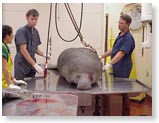|
 WILMINGTON, N.C.—New research findings have revealed that the toxins
produced during Florida red tides do pose a threat to marine mammals, even
after the blooms have disappeared. WILMINGTON, N.C.—New research findings have revealed that the toxins
produced during Florida red tides do pose a threat to marine mammals, even
after the blooms have disappeared.
As reported in the June 9 issue of Nature, scientists from the Florida Fish
and Wildlife Conservation Commission’s Fish and Wildlife Research Institute
(FWC/FWRI) and the University of North Carolina Wilmington Center for
Marine Science (UNCW/CMS) together with collaborators from Mote Marine
Laboratory, Harbor Branch Oceanographic Institution and the National
Oceanographic and Atmospheric Administration (NOAA) have discovered how
brevetoxin accumulation and transfer in the food web, a series of
interconnected food chains, resulted in mass fatalities of endangered
manatees in 2002 and bottlenose dolphins in 2004.
In Florida, red tides cause massive fish kills, contaminate shellfish with
brevetoxins making them unsafe for human consumption, and can cause
respiratory problems in humans.
Brevetoxins, the dangerous neurotoxins produced during Florida red tides
(blooms of the toxic microalga Karenia brevis) also have been implicated in
numerous mass marine mammal deaths in Florida. However, the mechanisms of
intoxication leading to their deaths have remained uncertain.
“We knew that brevetoxins were involved in manatee mortalities, but we did
not understand how these herbivorous mammals could be exposed to lethal
amounts of toxins after the red tide had dissipated,” said Leanne
Flewelling of FWRI’s Harmful Algal Blooms group and first author of the
publication.
A manatee is prepared for necropsy
Photo Credit: FWC
The authors reveal that brevetoxins can accumulate in high concentration on
seagrass, the principal food source for manatees, and can remain there
after the bloom is gone. This can be especially dangerous when the red
tides form in early spring and the migrating manatees move to coastal
waters, eating seagrass which has been exposed to the red tide toxins.
The involvement of brevetoxins in dolphin mortalities has been much
debated, primarily because toxins were not always found in dead animals and
because the source of the poisoning was not understood.
“Because red tides typically result in massive fish kills, people believed
that brevetoxins could not accumulate to concentrations dangerous for
marine mammals that feed on whole live fish prey,” said Jerome Naar,
research assistant professor at UNCW/CMS and corresponding author in the
publication.
With funding from the Centers for Disease Control and Prevention, the
Florida Department of Health and FWC, Naar, the principal investigator, and
Flewelling, along with Jan Landsberg (FWC/FWRI), co-PI, Karen Steidinger (FWC/FWRI)
and Daniel Baden (UNCW/CMS), all co-authors of the publication, have been
studying the potential for fish to accumulate brevetoxins by food-web
transfer and demonstrated that fish can be a significant source of vectored
brevetoxin in the food web.
They explained that planktivorous fish can in fact feed on the red tide
cells, but brevetoxin seems to be fatal to them only if the toxin passes
through their gills. When there is only a low level of toxin dissolved in
the seawater, these fish can become contaminated, particularly in the
internal organs, and can cause fatalities in other species, such as dolphin
or seabirds which rely on whole fish as a food source.
FWRI researchers perform a necropsy on a dolphin suspected to have died
from red tide
Photo Credit: FWC
The 2004 spring mortality of 107 dolphins in the Florida Panhandle was the
first evidence that brevetoxin-contaminated fish are a threat to dolphins.
“Discovering exactly the same toxin composition in the dolphin stomachs as
in the planktivorous fish gave us quite a good indication of what was
responsible,” Naar said.
“The finding that red tide is this toxic to manatees and dolphins
highlights the need for more research on the health effects of red tide
toxin exposure in human populations,” said David Schwartz, M.D., director
of the National Institute of Environmental Health Sciences.
Despite documented annual red tides in the Gulf of Mexico since the late
1800s, there are no reports of human poisonings from fish consumption in
red-tide impacted areas.
The investigation of the dolphin mortality led by NOAA included multiple
scientists from state and federal agencies as well as other non-profit
organizations and universities. Additional funding support for the study
was obtained from the Center for Sponsored Coastal Ocean Research Harmful
Algal Bloom Event Response Fund, the National Institute of Environmental
Health Sciences, NOAA’s Monitoring and Event Response for Harmful Algal
Blooms program, and the NOAA Marine Biotoxins Program.
|